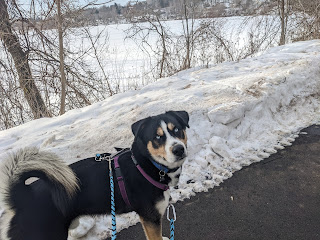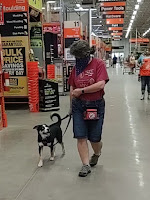Understanding K-9 emotions and how emotions can effect your dog's behaviors.
It's very important to understand that reactions to things in the environment are driven by emotions. In order to teach a dog to choose better behaviors in challenging situations, you need to address the emotions that are driving the behaviors the dog is demonstrating.
The easiest of emotions to recognize is when a dog reaches the "fight or flight" response. Often a dog who experiences this state frequently is labeled as a "reactive" dog. I detest labels! And the term reactive has to be the worst label people assign dogs. If you really think about it, ALL dogs & animals (even humans) are reactive. We react to things every day! Our stomach growls, we eat. A friend cries, we comfort. Someone cuts us off, we start yelling. I could go on! Animals need to eat, so satisfying that need by hunting and/or gathering is instinct. But animals learn not to hunt certain other animals due to emotions.
You've probably heard that elephants hate mice, and will therefore run away. I have never trained an elephant so I can't say if that's a true life situation or not but it's a perfect example to prove my point. FEAR is a very powerful EMOTION! Prey animals often avoid hunting other animals that have defense mechanisms that trigger fear or negative experiences. Most dogs are sprayed by skunks at least once in their life. Some dogs take longer to learn that lesson and get sprayed a few times before deciding to avoid smelly skunks. And yet other dogs have so much fun chasing skunks that they are willing to put up with the stench to experience the thrill of the case. This is a great example of how previous life experiences affect the emotions that drive our dogs' behaviors.
To change behaviors around distractions, you have to first change the emotions driving the behaviors. And for that you need to understand the emotional states dogs go through. This slideshow defines the basic emotional states or frame of mind that dogs can be in at any moment. Some dogs will transition more slowly as their reaction escalates, while others will transition from state to state very rapidly.
Comfortable is where we as people want for ourselves and our dogs most of the time. In this emotional state, we are happy & content with nothing around us that is impacting our behaviors. People tend to think of this as a "perfect world" environment and that carries over to our dogs. Comfortable is better than good, it's great!
Then spanning either way is a mild change that may not be perfect, but still easily accepted as an OK environment. Your dog might see or hear a bird then either reacts turning to look for the bird or completely ignoring the bird. This makes the bird interesting or no fun. Change the bird to another object such as a toy you want your dog to play with, for example I'll use Azul and a ball. A ball laying still on the floor is simply no fun for Azul who really doesn't like balls. The chances of Azul picking up a ball and bringing it to me in hopes of a game are very low because the ball is boring. If I pick up a ball Azul will pick his head up and look at me. He's thinking about what will happen next, he's interested.
Now add my ball obsessed dog Cam to the picture. Cam quickly escalates to a wired state if anyone in our house touches a ball. For Azul, this means his interest level increases greatly. He doesn't want the ball, but he loves when Cam runs so the ball predicts possible fun to begin.
Now if Azul was apprehensive of Cam, Cam's running could easily make Azul anxious. But what often happens is Azul darts back and forth a few times until he jumps to the next emotional state of being overwhelmed. He can no longer take the excitement and he begins trying to hump Cam. Azul is over-aroused! In this yellow state I need to calm things down preventing both dogs from moving into the next emotional states. In the yellow zones of being overwhelmed or anxious, it's still fairly easy to control the situation and guide both dogs back to a better state of being. Dogs who spend too much time in this yellow state tend to move really quickly into the orange and red states which is where all bad things happen.
A dog in the orange states of afraid or wired is no longer able to learn. If a dog hits these states, you need to make immediate changes to help your dog move back towards the center of the chart. Life in general is very unpredictable, so it's nearly impossible to have a life where the dog never hits these states. But we as people, have to do our best to try. Repeated exposures to triggers that send our dogs to an orange state can be very hazardous to our dogs. And some dogs after repeated exposures either stay in this state for very long periods of time (think months or years) or very quickly escalate to a redlined state, skipping this orange state entirely.
Redlined dogs are pretty much working on instinct, doing whatever behavior they need to use to improve the situation. And yes a dog can just as easily move from the center, “comfortable” state down the chart in happy ways to become over excited, wired, and red lined. We typically hear of this going the other direction from comfortable, to anxious, to afraid, to red lined. You've probably seen or heard of people describing that it was as if someone flipped a switch and their loveable dog turned into a wild beast.
So how do you keep your dog from moving into a red lined emotional state? Distance! You put distance between your team and the triggering distraction. How much distance? That depends on the dog! And how long it takes for the dog to move back to a calm state. I'll explain distance better in other posts.
Getting back to the situation with the ball.... Occasionally I allow Azul to chase Cam while Cam is playing ball. But then I have to watch Azul very closely, stopping the game before Azul is over-aroused. However, most of the time I leave Azul up on our porch which has a gate preventing Azul from reaching the ball game yard. Since Azul isn't running, he stays in a more neutral or excited state. Once Cam is done playing ball, I can switch places, leaving Cam on the porch and playing a game of tug with Azul.
Preventing escalation is always the best approach. The closer your dog moves toward the red area the higher their cortisone levels reach. And a dog who redlines will have higher cortisone levels for 3 days after the trigger. This is why we need to do our absolute best to help our dogs avoid entering the orange and red zones as much as we possibly can!
Our best training happens when we keep our dogs in the center 3 states of mind. It's nearly impossible to get a dog to redirect their focus back to their person unless they are in one of these emotional states. This is where we want them to stay when we are doing training sessions around distractions!





